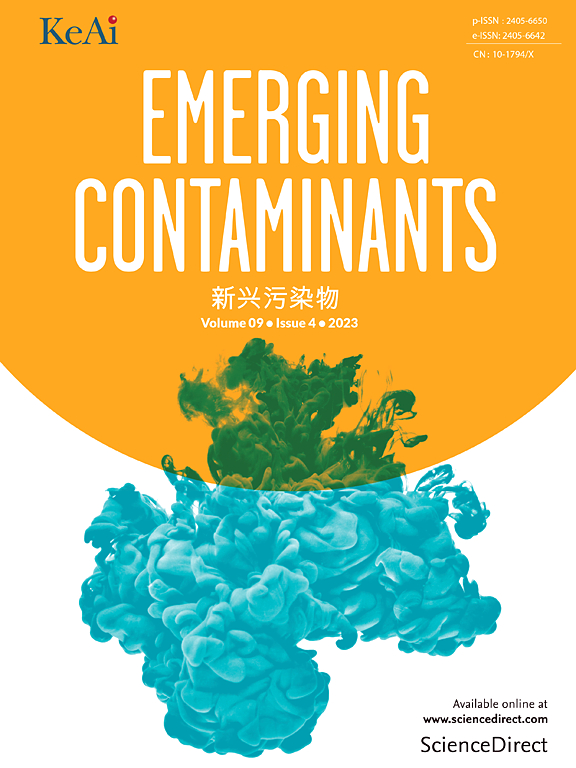Urinary exposure level of emerging chemicals in Chinese pregnant women and their associations with oxidative stress
IF 6.9
2区 环境科学与生态学
Q1 ENVIRONMENTAL SCIENCES
引用次数: 0
Abstract
Emerging chemicals (ECs), including parabens, bisphenols, bisphenol diglycidyl ethers, N,N′-substituted p-phenylenediamines, and benzotriazoles/benzothiazoles (BTH/BTRs), are widely used in industrial and consumer products. This study aimed to determine the urinary concentrations of 33 ECs and three oxidative stress biomarkers in pregnant women from a large birth cohort in Jiashan, China. Among the detected compounds, methyl paraben (MeP), bisphenol A (BPA), bisphenol A bis(2,3-dihydroxypropyl) glycidyl ether (BADGE·2H2O), N-isopropyl-N′-phenyl-1,4-phenylenediamine quinone (IPPDQ), and 1H-benzotriazole (1-H-BTR) were the most prevalent, with median concentrations ranging from 0.51 to 9.02 ng/mL. Notably, BTH/BTRs exhibited the highest exposure levels, approximately 4–16 times greater than those of other ECs. Most ECs showed elevated concentrations in pregnant women who were exposed to secondhand smoke prior to pregnancy. After model analysis, we found that mixtures of ECs were positively associated with both 8-hydroxy-2′-deoxyguanosine (8-OHdG) and 15(R)-prostaglandin F2α (15-PGF2α), while a negative trend was observed between ECs and 8-iso-prostaglandin F2α (8-PGF2α). Specifically, urinary benzyl paraben (BzP), BPA, bisphenol S (BPS), N-(1,3-dimethylbutyl)-N′-phenyl-1,4-phenylenediamine quinone (6PPDQ), IPPDQ, 2(3H)-benzothiazole (2-OH-BTH), and 2-methylthio-benzothiazole (2-Me-S-BTH) or 1-H-BTR were significantly (p < 0.05) associated with 8-OHdG. MeP, 6PPDQ, and 2-Me-S-BTH were linked to 15-PGF2α, while only bisphenol A (2,3-dihydroxypropyl) glycidyl ether (BADGE·H2O) showed a significant positive association with 8-PGF2α. This study provides a comprehensive evaluation of the exposure characteristics of ECs and their associations with oxidative stress biomarkers in pregnant women, offering new insights into the health risks associated with ECs exposure during critical periods of pregnancy.

中国孕妇尿中新化学物质暴露水平及其与氧化应激的关系
新兴化学品(ECs),包括对羟基苯甲酸酯、双酚类、双酚二甘油酯醚、N,N '取代对苯二胺和苯并三唑/苯并噻唑(BTH/BTRs),广泛用于工业和消费品中。本研究旨在测定中国嘉山一个大型出生队列孕妇尿液中33种ECs和3种氧化应激生物标志物的浓度。在检测到的化合物中,对羟基苯甲酸甲酯(MeP)、双酚A (BPA)、双酚A双(2,3-二羟丙基)甘油基醚(BADGE·2H2O)、n -异丙基- n ' -苯基-1,4-苯二胺醌(IPPDQ)和1h -苯并三唑(1-H-BTR)含量最高,中位浓度为0.51 ~ 9.02 ng/mL。值得注意的是,BTH/BTRs的暴露水平最高,约为其他ec的4-16倍。大多数ECs显示,在怀孕前暴露于二手烟的孕妇中ECs浓度升高。通过模型分析,我们发现ECs与8-羟基-2′-脱氧鸟苷(8-OHdG)和15(R)-前列腺素F2α (15- pgf2 α)呈正相关,而与8-异前列腺素F2α (8-PGF2α)呈负相关。其中,尿对羟基苯甲酸苄酯(BzP)、BPA、双酚S (BPS)、N-(1,3-二甲基丁基)-N ' -苯基-1,4-苯二胺醌(6PPDQ)、IPPDQ、2(3H)-苯并噻唑(2- oh - bth)、2-甲基硫-苯并噻唑(2- me -S- bth)或1- h - btr显著(p <;0.05)与8-OHdG相关。MeP、6PPDQ和2- me - s - bth与15-PGF2α呈显著正相关,而只有双酚A(2,3-二羟丙基)缩水甘油酯(BADGE·H2O)与8-PGF2α呈显著正相关。本研究全面评估了ECs的暴露特征及其与孕妇氧化应激生物标志物的关联,为妊娠关键时期ECs暴露相关的健康风险提供了新的见解。
本文章由计算机程序翻译,如有差异,请以英文原文为准。
求助全文
约1分钟内获得全文
求助全文
来源期刊

Emerging Contaminants
Medicine-Public Health, Environmental and Occupational Health
CiteScore
10.00
自引率
6.70%
发文量
35
审稿时长
44 days
期刊介绍:
Emerging Contaminants is an outlet for world-leading research addressing problems associated with environmental contamination caused by emerging contaminants and their solutions. Emerging contaminants are defined as chemicals that are not currently (or have been only recently) regulated and about which there exist concerns regarding their impact on human or ecological health. Examples of emerging contaminants include disinfection by-products, pharmaceutical and personal care products, persistent organic chemicals, and mercury etc. as well as their degradation products. We encourage papers addressing science that facilitates greater understanding of the nature, extent, and impacts of the presence of emerging contaminants in the environment; technology that exploits original principles to reduce and control their environmental presence; as well as the development, implementation and efficacy of national and international policies to protect human health and the environment from emerging contaminants.
 求助内容:
求助内容: 应助结果提醒方式:
应助结果提醒方式:


